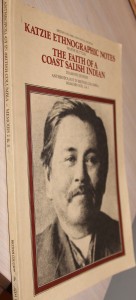These days we would say First Nations, but during  anthropologist Diamond Jenness’s day–this book first published in 1955–the term Indian was widely used when referring to the natives of the Americas. Jenness had the best intentions and made genuine friendships when studying various First Nations in the 20th century, but certainly the misnomer of “Indian” was eventually mostly done away with. The book, with Katzie Ethnographic Notes by Wayne Suttles, was published after Jenness’s original manuscript on the Coast Salish natives. The record was related by Peter Pierre, age 75, who had trained in medicine and oral history of the Katzie people, looked over by elders. Peter’s son Simon, in turn, worked later as an interpreter for his father. Peter died in 1946. Suttles also worked with Simon to publish Jenness’s manuscript, and that’s how this book came about.
anthropologist Diamond Jenness’s day–this book first published in 1955–the term Indian was widely used when referring to the natives of the Americas. Jenness had the best intentions and made genuine friendships when studying various First Nations in the 20th century, but certainly the misnomer of “Indian” was eventually mostly done away with. The book, with Katzie Ethnographic Notes by Wayne Suttles, was published after Jenness’s original manuscript on the Coast Salish natives. The record was related by Peter Pierre, age 75, who had trained in medicine and oral history of the Katzie people, looked over by elders. Peter’s son Simon, in turn, worked later as an interpreter for his father. Peter died in 1946. Suttles also worked with Simon to publish Jenness’s manuscript, and that’s how this book came about.
The modern day Katzie First Nation is thankful to both Peter Pierre and Diamond Jenness for relating early accounts of the First Nation–their accounts are confirmed by other elders in the past. The current Katzie people are descendents of the first five communities of the Lower Fraser, placed by their creator at territories now found at some of my nearby neighborhoods: Pitt Lake, Sheridan Hill, Port Hammond, and Point Grey.
According to the Katzie website:
The people came to be known as the Katzie people descend primarily from Oe’lecten and his people, created at the south shore of Pitt Lake, and Swaneset and his people, created at Sheridan Hill.
Xwoe’pecten and his people, created at Port Hammond, joined with Swaneset’s people at Katzie, but later moved to what is now New Westminster and gave rise to the people now known as the Kwantlen people.
Smakwec and his people, created at Point Roberts, and their history, lands, resources, and culture were closely linked to those of the Katzie people. The descendants of Smakwec and his people are many, but many have vanished. The Nicomekl, as a distinct people, vanished in the time of the smallpox epidemic of the 1700s.
C’simlenexw and his people, created at Point Grey, are the principle ancestors of the people now known as the Musqueam.
Anyway, I ordered this book from a private seller on Amazon.ca, and it is in good condition with little wear and tear.
I also happen to work with the Diamond Jenness’s grandson, who told me all about his grandfather’s exploration of the Arctic–one of the first, if not the first, to learn First Nations’ customs and languages whilst exploring the area. Given that anthropology was one of my undegraduate degrees, and the northwest temperate rainforest is a key interest of mine, this historical book is perfect for my tastes.